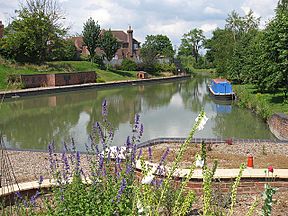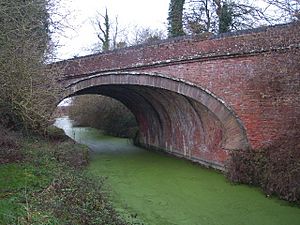Herefordshire and Gloucestershire Canal facts for kids
The Herefordshire and Gloucestershire Canal is a historic canal in western England. It once connected the city of Hereford to Gloucester, where it joined the River Severn. The canal was built in two main parts, opening in 1798 and 1845. It stopped being used in 1881. Part of its route was later used to build the Ledbury and Gloucester Railway. Today, people are working hard to bring this old canal back to life.
Contents
History of the Canal
Planning the Canal's Route
The idea for a canal between Hereford and Gloucester first came up in 1777. Robert Whitworth, a student of the famous engineer James Brindley, drew up the first plans. Later, in 1790, a group of people decided to ask Parliament for permission to build it.
They hired Josiah Clowes as the engineer. He suggested a route that would go through Ledbury. There would also be a small branch to Newent, where some coal could be found. The canal was designed for boats that were 70 by 8 feet (21.3 by 2.4 m) big. These boats could carry about 35 tons of goods. The estimated cost was £70,000. People thought the canal would make good money by carrying goods. In April 1791, Parliament officially approved the plan.
Building Challenges and Delays
In 1792, another engineer, Hugh Henshall, suggested a change to the route. This new plan included a tunnel at Oxenhall. A second Act of Parliament was needed and approved in 1793. Sadly, Josiah Clowes died in 1795. Robert Whitworth took over as the chief engineer.
By late 1795, the first part of the canal was open to Newent. But the Oxenhall tunnel caused huge problems. Workers had to dig 20 shafts along the tunnel's path. This allowed them to work from many places at once. However, a lot of water kept flooding into the shafts. Horse-powered pumps were not strong enough. They had to use steam-powered pumps, which cost a lot more money. This tunnel was a big reason why the canal cost so much and took so long to finish.
The canal reached within a mile of Ledbury in 1798. But it stopped there because the costs were much higher than expected. The branch to the Newent coal mines was not successful. The coal there was not very good quality. This part of the canal quickly stopped being used. Ledbury remained the end of the canal for 40 more years. A small extension was built in 1832 to deliver coal to the Ledbury gas works.
Completing the Canal
In 1827, Stephen Ballard became the new manager of the canal company. He wrote a report in 1829 about how to finish the canal. In 1839, a new Act of Parliament was passed. This allowed the company to raise money to complete the canal. Work started on November 17th.
A water supply from the River Frome was finished in August 1842. The canal then opened in stages. It reached Canon Frome wharf in January 1843. Then it extended to Whithington wharf in February 1844. Finally, it reached Hereford basin on May 22, 1845.
Just like the first part, building the tunnels was the hardest job. The Ashperton tunnel was only 400 yards (370 m) long. But it also had problems with water and unstable rock. This meant they had to line it with brick and stone. Again, the costs went way over budget.
Life of the Canal
The canal ended up costing much more than anyone planned. The whole canal was first estimated at £69,997. But just the section to Ledbury cost over £104,000. The second part was estimated at £53,000 but ended up costing £141,436.
Even with the canal finished, trade didn't increase much. The company tried to sell it to a railway company almost right away. When that didn't work, they tried to get more businesses to use the canal.
Traffic did start to grow. By 1849, so many boats were using the Oxenhall tunnel that a timetable was needed. But this didn't always work. In 1851, two boats met in the middle of the tunnel. Neither boat would move, and they were stuck for 58 hours!
Decline and Closure
In 1858, the canal carried 47,560 tons of goods. It made £7,061 in 1860. Some of this money came from carrying materials to build new railways. On January 17, 1862, less than 17 years after the canal reached Hereford, it was leased to the Great Western Railway and West Midland Railway. The railway companies wanted to turn it into a railway line.
This didn't happen right away. But on June 30, 1881, half of the canal was closed. Parts of it were used for the Ledbury and Gloucester Railway. The section from Hereford to Ledbury stayed open for a while. But it slowly stopped being used. The Canal Company continued to get rent from the Great Western Railway. It wasn't officially closed until 1948, when the railways were taken over by the government.
Canal Route and Features
The canal stretched for 34 miles (55 km). It started at Hereford basin and went through Ledbury, Dymock, and Newent. It ended at Over, near Gloucester, connecting to the River Severn. There was also a short branch to the coal fields at Gorsley.
The first 6 miles (9.7 km) from Hereford to Withington was flat. This section includes the Aylestone tunnel. After that, the canal rose 37 feet (11 m) through three locks over three miles to Monkhide. This part has the interesting skew bridge at Monkhide. It was built by Stephen Ballard at a sharp angle of only 27 degrees to the canal. This bridge is made of red brick and is a Grade II listed structure, meaning it's an important historical building.
Then there's another flat section of over twelve miles to the edge of Ledbury. This includes the Ashperton tunnel. Water is added to this section from the River Frome. The last 18 miles (29 km) to Over drops 195 feet (59 m). This part includes the 2,192-yard (2,004 m) long Oxenhall tunnel. The railway company wisely built a new path around this tunnel instead of trying to make it bigger. The coal branch left the canal below this tunnel.
The canal had 22 locks and three tunnels. Like many English canals, it was built for narrowboats to carry important goods.
Bringing the Canal Back to Life
In 1983, some articles about the canal appeared in local newspapers. This led to people wanting to form a group to save the canal. A meeting was held in Hereford, and a canal society was formed. This group quickly started working on restoring the canal. At first, their goal was just to protect what was left. But in 1992, the society became the Herefordshire and Gloucestershire Canal Trust (H&G Canal Trust). Their new goal was to fully restore all 34 miles (55 km) of the canal and its locks. They want Hereford to be connected again to Ledbury, Dymock, Newent, and the rest of the waterway system at Gloucester.
Since 1991, local councils in Herefordshire have set aside land for the canal. They have approved building projects that consider the canal route. They have also stopped people from building on the proposed canal path. Councils in Gloucestershire have given similar support.
In 2000, volunteers from the Canal Trust and the Waterway Recovery Group rebuilt the Over Canal Basin. This basin is next to the River Severn at Over, where the canal connects to the waterways. This work would have cost about £500,000 if done by a company. But volunteers did it for only £60,000! The basin had been filled in when a hospital was built in 1903. The land was sold for houses, and it was agreed to dig out the basin to improve the area. A new canal center, Wharf House, was also built.
In late 2011, the Trust bought a short section of the canal above the basin. This part was also restored by volunteers. It was refilled with water by April 2012, ahead of schedule. Timothy West and Prunella Scales officially reopened it at the 2012 Over Canal Festival.
Big building projects in Hereford city center have created a new canal bed. This will eventually connect to a new basin. It will be a main feature of the Edgar Street Grid development. Work has also happened on the Aylestone Park section. After cleaning out mud with heavy metals, a short part of the canal at Aylestone was used for a boat rally in May 2011. Boats could be launched using a slipway, and the canal will be made wider later.
The canal connects to a part of the River Severn that boats can't use. This is because of weirs (small dams) at Maisemore and Llanthony. Both places have old, unused locks. The Canal Trust bought the Llanthony site in 2007. This site includes two cottages, some land, a small part of the River Severn, and Llanthony lock. This lock is bigger than the one at Maisemore. It's also easier for boats to reach the entrance lock at Over from here.
At Newent, Bridge Street used to cross over the canal. When the railway replaced the canal, they built a high bridge over the road. The Canal Trust thought about rebuilding the canal between the platforms of Newent railway station. But this would need very large banks of earth, which wouldn't look good. So, in 2019, they thought of a new idea: an inclined plane. This would use a special cradle on rails to lift boats up to the station level. Then, after a flat section between the platforms, another incline would lower them back down to the canal on the other side.
Visitor Centre
The Wharf House is the Herefordshire and Gloucestershire Canal Trust's visitor center. It has tea rooms during the day and a restaurant at night. It's located at Over, near the A417/A40 roundabout, about 1 mile (1.6 km) west of Gloucester. All the money made here goes to the H&G Canal Trust Charity to help restore the canal.



